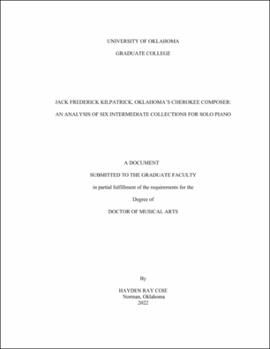| dc.description.abstract | Jack Frederick Kilpatrick (1915 – 1967) was the first Cherokee to receive widespread acclaim as a composer. Born in Stilwell, OK, Kilpatrick learned music at an early age and earned music degrees from the University of Redlands and American Catholic University. Kilpatrick was eventually awarded an honorary doctorate in music from the University of Redlands in 1950. In addition to working as a composer, Kilpatrick was also a professor of theory at the U.S. Naval Academy of Music, and later Southern Methodist University where he served on the faculty until his death in 1967. Many of Kilpatrick’s nearly 550 works were lost until their recent discovery in 2018, when 31 boxes of his manuscript scores were discovered in Catlett Music Center at the University of Oklahoma. Among this discovery were 58 individual works for solo piano across 26 opus numbers, whose difficulty ranges from early intermediate to advanced concert works.
This document analyzes six of Kilpatrick’s collections for solo piano suitable for intermediate students. Analyses include an investigation of compositional features, stylistic influences, and pedagogical considerations. Each collection is leveled according to the system presented in Jane Magrath’s Piano Literature for Teaching and Performance. Chapter 1 provides the overview, purpose, and procedures for the study. Chapter 2 reviews literature related to Kilpatrick’s life and the appropriation of Native American music; due to the lack of existing literature on Native American piano composers, Chapter 2 also reviews extant works for solo piano by Native American composers. Kilpatrick’s known biography and summaries of his piano collections are presented in Chapter 3.
Chapter 4 analyzes two collections for early intermediate students (levels 3 – 4): Two Country Store Yarns, Op. 111, and From the Ranch Next Door, Op. 133. Chapter 5 examines two mid-intermediate collections (levels 5 – 6): Three Little Pieces for Children, Op. 33, and Two Pieces for Piano, Op. 110. Chapter 6 evaluates the following two collections for late intermediate students (levels 7 – 8): Two Vignettes of Cherokee Life, Op. 106, and Two Pieces for Piano, Op. 88.
The conclusion in Chapter 7 summarizes the findings of this research, including a review of Kilpatrick’s style and contributions as a composer and scholar. The author also offers possible avenues of future research. By studying Kilpatrick’s newly discovered works for piano, pianists and teachers can now explore the significant musical contributions of history’s most prolific Cherokee composer. | en_US |
